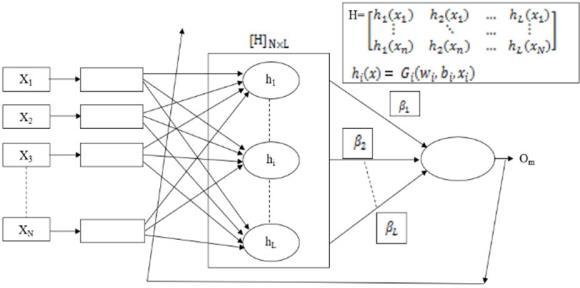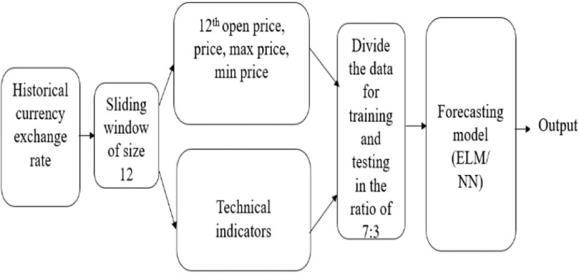
International Research Journal of Engineering and Technology (IRJET) e‐ISSN:2395‐0056 p‐ISSN:2395‐0072

Volume: 11 Issue: 03 | Mar 2024 www.irjet.net

EXPLORING THE PREDICTION ANALYTICS BY FORECASTING MODEL(ELM/NN) FOR EXCHANGE RATE CURRENCY PREDICTION
1K Gowtham, 2V Jaswanth, 3G S R A R Pramod, 4J Datta Darshan
1,2,3,4Student, GITAM (Deemed to be University), Visakhapatnam, Andhra Pradesh, India
Abstract ‐ We employ a cutting‐edge technique to predict currency prices in financial markets that combines the Jaya optimization method with the Extreme Learning Machine (ELM) algorithm. This approach simplifies the process of currency price prediction and market analysis. While conventional neural network training methods tend to be computationally demanding and iterative, our method leverages the ELM algorithm's efficiency in randomly generating input‐hidden layer weights and analytically determining output weights. This method speeds up neural network training considerably. Furthermore, the integration oftheJayaoptimizationapproachaimstodynamicallyadjust hyperparameters,whichfurtherimprovestheperformanceof the ELM algorithm. Combining ELM with Jaya optimization promises to simplify neural network training, making it more efficient and effective in predicting currency prices in trading and market analysis.
Key Words: Extreme Learning Machines (ELM), Neural Networks (NN), Time‐Series Data, Jaya Optimization, Economic Forecasting.
1. Introduction
Due to the constantly shifting and unexpected nature of currencyfluctuations,predictingtradingcostsintheforeign exchangemarketiscomplexandcomprehensive.Theforex marketischaracterizedbysharposcillationsdrivenbymany dynamicvariables,incontrasttomorestaticsectorssuchas climateprediction,wherecomponentschangegraduallyover time.Thesevariablesincludemonetarypolicies,geopolitical events,marketmood,andeconomicindicators,amongmany othereconomic,political,andsocialinfluences.
Evenlittledeparturesfromexpectedcurrencymovements may have substantial financial ramifications in the forex market.Thus,itiscriticaltomakepreciseandtimelyforecasts. Tradersandinvestorsusepredictivemodelstoanticipate future changes in exchange rates and help themdecide whether to purchase, sell or hold onto their currency. However, to fully account for the subtleties and complexity present in forex trading, typical forecasting techniques often need assistance, resulting in subpar performanceandlostchances.

Innovative methods like Jaya Optimization and Extreme LearningMachines(ELM)havedevelopedaspotentialtools forcurrencyexchangeratepredictioninresponsetothese issues.ThemachinelearningalgorithmELMisnotableforits ease of use, effectiveness, and adaptability. ELM has a strategydifferentfromtraditionalneuralnetworktraining algorithms, which call for iterative optimization using methodslikegradientdescent.Thismethodeliminatesthe need for time-consuming and repetitive training by calculatingoutputweightsthroughanalysisandassigning randomvaluestoinputweights.Thismethodenablesquick adaptabilitytoshiftingmarketcircumstances,essentialin thevolatileandfast-pacedforexmarket.Italsocutsdownon trainingtimeandcomputingcomplexity.
Jaya Optimization provides a robust framework for optimizing predictive models to improve performance whencombinedwithELM.JayaOptimizationisinspiredby thecooperativebehaviorseeninsocialcontexts,simulating how people pick up on and modify the behaviors of their peerstobetterthegroupasawhole.Whenusedtoforecast currency exchange rates,JayaOptimizationmay optimize network architecture and hyperparameters, among other ELM model characteristics. Jaya Optimization helps enhancetheefficacyandaccuracyofELM-basedforecasting models by repeated refining based on observable performance indicators,which eventually resultsinmore accurateforecastsandimprovedtradingoutcomes.
Trading professionals and financial analysts may use cutting-edge methods to understand the dynamics of the forexmarket better andimprove their tradingjudgments by combining ELM with Jaya Optimization. By enabling traderstoseehiddenpatternsandtrendsinexchangerate data, these tools provide insightful predictions that guide tradingstrategiesandapproachestoriskmanagement.All things considered, the combination of ELM with Jaya Optimization marks a noteworthy breakthrough in forecastingcurrencyexchangerates,withthepossibilityof improvingtradingprofitability,efficiency,andaccuracy
2.Literature Survey
[1] MinakhiRout,BabitaMajhi,RitanjaliMajhiand GanapatiPandatitled"Forecastingofcurrencyexchange


Volume: 11 Issue: 03 | Mar 2024 www.irjet.net
International Research Journal of Engineering and Technology (IRJET) e‐ISSN:2395‐0056 p‐ISSN:2395‐0072

rates using an adaptive ARMA model with differential evolution-based training". Previous research has offered methodsusingsoftcomputingandevolutionaryalgorithms toovercomelimitationsofstatisticsbasedforeignexchange rateforecastingtechniques.Tofurtheradvancethestudyin thisfield,thisworkproposesastraightforwardyeteffective hybrid prediction model by successfully combining an adaptive autoregressive moving ave-rage (ARMA) structure with the training of its input and feed-back parameters using differential evolution (DE). The prediction model's internal coefficients are trained using the DE optimization technique by extracting surface statistical features for each exchange rate from a sliding windowofpastdata.Thepredictionaccuracyisconfirmed byutilizingpastexchangeratesnotusedfortraining.Three different exchange rates are shown by simulation results usingaccurateworlddata,withestimatesrangingfromone tofifteenmonthsahead.Thisanalysislooksathowwella sugge-sted forecasting model predicts exchange rates compare-d to four other common approaches: ARMA combinedwithparticleswarmoptimization(PSO),ARMA combined with forward backwards least mean square (FBLMS), ARMA combined with bacterial foraging optimization(BFO),andARMAcombinedwithcatswarm optimization(CSO).Themodelthatperformstheworstis the derivative-based combination of ARMA and FBLMS. Whenconsideringtraininglength andother performance measures,the recommendedARMAdifferentialevolution exchangeratepredictionmodeloutperformstheothertwo evolutionary computing-based models both in the short termandlongterm.
[2] Svitlana Galeshchuk titled "Neural networks performanceinexchangerateprediction".Tofindthemost instructive characteristics for input into neural network models, input selection entails examining variables like economic indicators, geopolitical events, and market sentiment after data collection and preprocessing. To increase performance, model training and optimization include experimentation with various topologies, such as feedforward,recurrent,orconvolutionalneuralnetworks, along with hyperparameter tweaking and optimization methods like gradient descent or genetic algorithms. Modelperformanceismeasuredusingevaluationmetrics, andtheirgeneralizabilityisconfirmedbytestingdatathat is not in the sample. Time series and scatter plots are examples of visualizations that show how effectively the models represent underlying patterns and trends in exchange rate data. By comparing the outcomes oftraining and testing, disparities may be analyzed, and possible areas for improving the modelling strategy can be found. Overall, the construction of reliable neural network models for exchange rate prediction is made possible by this iterative process of data gathering, preprocessing,modeltraining,assessment,andanalysis.


[3]SalimLahmiri titled "Modeling and predictinghistorical volatility in exchange rate markets". Forecasting how much currency exchange rates change is important for several financial tasks. These include checking portfoliorisk, pricing financial contracts, and managing company money risk. This study looks at a simple¬ way to predict exchange rate¬ volatilityinthepast.Thesuggestedmethodworkswellbyusing afewcommontechnicalindicatorsasinputsforartificialneural networks (ANN). It focuses on the US/Canada dollar rate and the US/euro rate. The results show that our low-complexity method does better than usual volatility models. These include versions of GARCHand EGARCH combined with ANN based on errors like averageabsoluteerror,averagesquared errors, and Theil's inequality measure. This technique can improve US currency volatility prediction efforts due to its simplicity and efficacy, demonstrating its usefulness in practicalapplicationsandfinancialdecision-makingscenarios.
3. Project Goal
This research will combine the speed and efficiency of extreme learning machines with the extensive pattern recognitioncapabilitiesofneuralnetworkstoprovidemore preciseandaccurateexchangeratefluctuationestimates.
4.Problem Identification
Thecomplexdynamicsofcurrencyvaluesarechallengingfor conventional forecasting techniques to fully capture due to their unpredictable character, which is impacted by many otherfactors,includingmarketemotion,geopoliticalevents, andeconomicdata.
5. Dataset Description
Thedatasetwe'reworkingwithforforexexchangerateshas manydata:12differenttypesofinformationand3392separate records. By performing thedatapreprocessingand removing the nullvaluesandothergarbagevalues,thedatasetrecordcount waschangedto3366.
So,thedatasetsize3366x12ofdatahasatimestampthattells uswhenitwasrecordedandotherinformationlikehowmuch wastraded,thepriceatthebeginningandendoftrading,the highestandlowestprices,andothereconomicfactorsthataffect howcurrencieschange.
Thisletsustakeacloselookathowtheforexmarketchanges andwhattrendsarehappening.
Inaddition,welookedatdatasetsthathadinformationfrom differentfinancialinstruments,suchasessentialcurrencypairs likeUSD/EURandUSD/INR.


Thedatasetisfurtherdescribedasfollows.

Table 1: DatasetattributesandDescription 6. Proposed Method

6.1 Architecture

Fig 2: Architecture
• The Exchange Rate Currency Prediction project emerges as a pivotal tool with wide-ranging implications.


• Weconsidertimeseriesdata,whichindicatesthe opening price, closing price, and high and low valuesonthatparticularday.
• The described methodology considers the sliding windowsize12fortheattributesopenprice,max price,andminpriceforthatspecificdata.
• Ourmethodologyincorporatestechnicalindicators including: Simple Moving Average (SMA), True Range (TR), Average True Range (ATR), Exponential Moving Average (EMA), Moving AverageConvergenceDivergence(MACD).
• Oncedataissplitintotrainingandtestingsubsets, machine learning models can be applied to the training data. Techniques like extreme learning machinesorneuralnetworksallowthesemodelsto generate predictions for new data, utilizing their learnedpatternsfromthetrainingdata.
6.2 Working of Model

Fig 3: Processofworking
• The user requests the Currency Predictor for informationabouttheexchangerates.
• TheCurrencyPredictorgetstheexchangeratedata fromacollectionofdatacalledtheExchangeRate Dataset.
• TheCurrencyPredictorusesthecollecteddatato estimatehowmuchcurrencieswillbeworth.
• TheCurrencyPredictorsendstheestimatedrates backtotheuser.
6.3 Technical Indicators
• SimpleMovingAverage(SMA):Theaverageprice of an investment over a given timeframe. This is calculated by totaling the prices over that period and dividing the sum by the number of time periods.
• True Range (TR): A volatility indicator that calculatesthelargestofthreevalues:1.Difference between current High and Low 2. Absolute difference between current High and previous Close3.AbsolutedifferencebetweencurrentLow andpreviousClose.


Volume: 11 Issue: 03 | Mar 2024 www.irjet.net
International Research Journal of Engineering and Technology (IRJET) e‐ISSN:2395‐0056 p‐ISSN:2395‐0072

• Average True Range (ATR): The Average True Range (ATR) is a volatility indicator that gauges market volatility by calculating the average True Rangeoveraspecifiedtimeperiod.
• ExponentialMovingAverage(EMA):Thismoving averageprioritizesthemostrecentdata,allowingit toreactswiftlytochangesandprovidemoreup-todate insights compared to a regular moving average.
• MovingAverageConvergenceDivergence(MACD): This indicator tracks trends and momentum by comparingtwomovingaveragesofastock'sprice. It calculates the difference between the moving average over the past 12 periods and the moving averageoverthepast26periods.
7. Results

The model predicting exchange rates between the US dollar (USD), the Euro (EURO), and the Indian Rupee (INR) is very accurate. This is shown by the close alignment of the lines on the graph, indicating that the model accurately reflects the factors that influence the exchangerates.ThestableeconomicconditionsintheUS, Eurozone,andIndiacontributetothisaccuracy.Allthree countrieshavewell-managedpolicies,lowinflation,and consistent economic growth. These stable economic environments lead to predictable changes in exchange rates,makingthem easiertoforecast.The modelisalso accuratebecauseitincludesmanyimportantfactorsthat affect currency exchange rates, such as interest rates, inflation gaps, economic growth, trade balances, and political stability. The success of the model shows that these variables can effectively predict movements in currencyexchangerates.Duringthetimeframestudied, there were few economic surprises, which helped keep predicted and actual exchange rates aligned. By continuallyrefiningourmodels,wecanforecastcurrency


exchangeratesmoreaccurately.Themodelshowsthatit isessentialtotakeintoaccountmanydifferentthingsand do a thorough analysis in order to make accurate predictions.
8. Conclusion
A critical instrument with broad consequences is the Exchange Rate Currency Prediction project. Its application is widespread in essential fields like governmentpolicy,corporatefinance,trade,andfinance. Bygivingpreciseforecasts,theprojecthelpsbusinesses plan ahead and hedge currency exposure, investment managers make well-informed decisions, central banks andgovernmentswitheconomicplanning,andfinancial institutionsoptimizeportfoliosandreducerisks.
9. Future Work
The Exchange Rate Currency Prediction project has a bright future ahead of it, full of chances for strategic applications,innovation,andoptimizationinavarietyof fieldsandbusinesses.Itsvaluepropositionandeffecton the global financial scene may be further enhanced by ongoing developments in prediction methodology and technologicalintegration.
10. Reference
[1] Minakhi Rout, Babita Majhi, Ritanjali Majhi, GanapatiPanda:Forecastingofcurrencyexchange rates using an adaptive ARMA model with differentialbasedevolution
[2] Svitlana Galeshchuk: Neural networks performanceinexchangerateprediction.
[3] SalimLahmiri: Modeling and predicting historical volatilityinexchangeratemarkets

